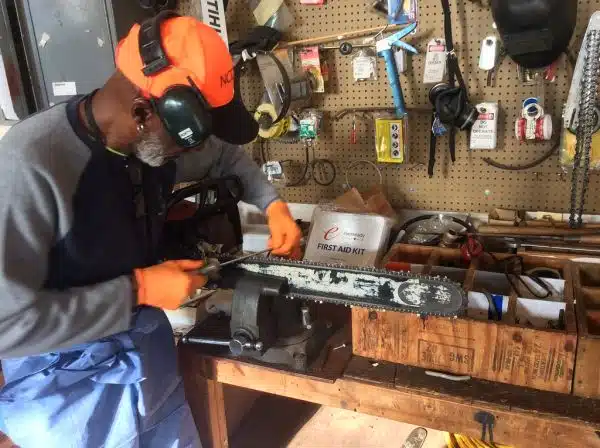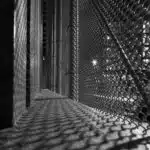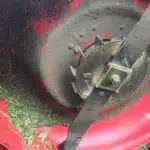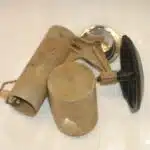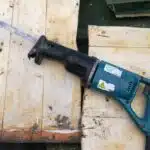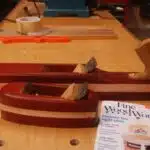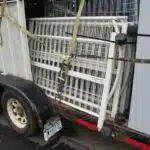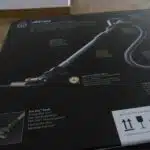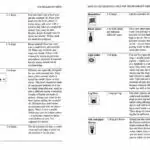As a chainsaw sharpening expert, I have seen countless chainsaws that have been improperly sharpened. A dull chainsaw blade not only makes it difficult to cut through wood and other materials, but it can also be dangerous for the user. Knowing how to properly sharpen a chainsaw is essential for both effective cutting and safety.
In this article, I will share my knowledge on the proper techniques for sharpening a chainsaw. From inspecting the chain for damage to selecting the right file size, I will provide step-by-step instructions for achieving a sharp and safe chainsaw blade. Whether you are a homeowner looking to maintain your own equipment or a professional in need of a refresher course, this guide will provide valuable tips and tricks for properly sharpening your chainsaw.
Understanding Chain Anatomy
The key to properly sharpening a chainsaw is understanding the anatomy of the chain. A typical chainsaw chain consists of teeth that are arranged in a sequence, each with its own cutting edge. The cutting edges are angled and shaped to create a smooth and efficient cut as they rotate around the guide bar. Understanding the tension of the chain is crucial as it affects how smoothly it moves along the guide bar.
Choosing the right lubricant for your chainsaw is also essential. Chainsaws operate at very high speeds, which creates a lot of friction between the guide bar and chain, leading to wear and tear. Lubricating oil reduces this friction, extending the life of both parts. Typically, any good quality oil designed specifically for chainsaws will work well.
Inspecting the chain for damage should always be done before sharpening it. Look out for broken or chipped teeth, or signs of excessive wear on both sides of each tooth. It’s important to replace any damaged parts before proceeding with sharpening to prevent further damage or injury during use. With these factors in mind, you’re now ready to move onto inspecting your chainsaw chain for damage before beginning the sharpening process.
Inspecting The Chain For Damage
Like a surgeon carefully examining a patient before performing a critical operation, we must inspect our chainsaw before sharpening it. Inspecting techniques are crucial in identifying any damage that may have occurred during use. This step is important to ensure safety and optimal performance of the chainsaw.
The first step in inspecting the chain is to check for damaged or missing teeth. If left unattended, these can cause serious problems during use and result in accidents. The second step is to check if the depth gauge teeth are at the correct height. These teeth control the depth of cut made by each cutter and need to be adjusted correctly for efficiency and safety.
When identifying damage, look for any signs of wear or tear on the chain’s links and rails. Loose rivets or broken links can cause significant problems if not fixed promptly. Also, check for any bent or cracked guide bars as they can cause excessive vibration during use, which can lead to fatigue and discomfort.
Now that we have inspected our chainsaw and identified any issues, we can move on to preparing it for sharpening. Ensure that you have all the necessary tools required for this task before proceeding further.
Preparing The Chainsaw For Sharpening
- Before beginning the sharpening of a chainsaw, it is essential to inspect the saw for existing defects or damage.
- The work area should be well-lit and free of debris to ensure the safety of the user.
- The chain should be checked for tension, as it will determine the success of the sharpening.
- The chain should be removed from the chainsaw and laid out in a manner that allows for easy access to the cutters.
- It is important to ensure that the chain is cleaned of all debris as this will ensure that the sharpening is as effective as possible.
- Finally, the sharpening angle should be checked and adjusted if necessary to ensure the chain is sharpened properly.
Inspecting The Chainsaw
Before you start sharpening your chainsaw, it is important to inspect it thoroughly to ensure that it is in good condition. This involves cleaning and lubricating the chainsaw and identifying any worn out parts. Regular cleaning of the chainsaw is important to prevent dirt, sawdust, and debris from clogging the machine. Lubrication ensures that the chainsaw runs smoothly during operation.
Inspecting the chainsaw also involves checking for any signs of wear and tear on various parts such as the chain, bar, sprocket, and clutch drum. Make sure that these parts are in good condition before you start sharpening your chainsaw. A worn out chain or bar can cause a lot of damage to both you and your machine during operation.
Identifying worn out parts and replacing them before sharpening your chainsaw can save you a lot of time and money in the long run. Neglecting this step can lead to poor performance or even damage to your machine. Therefore, always remember to inspect your chainsaw thoroughly before sharpening it to ensure that it is safe to use and will perform at its best.
Preparing The Work Area
After a thorough inspection of your chainsaw, the next step in preparing it for sharpening is to clear the work area. This involves removing any debris or obstacles that may hinder your movement while sharpening. A clear work area ensures that you have enough space to move around safely and efficiently. It also reduces the risk of accidents during operation.
Securing the chainsaw is also crucial in preparing the work area. You need to ensure that the chainsaw is stable and won’t move around while you are sharpening it. This can be achieved by using a vice or clamp to hold the chainsaw in place. Alternatively, you can use a non-slip mat or bench to secure the machine.
It’s important to note that preparing the work area before sharpening your chainsaw is just as important as inspecting it for wear and tear. Neglecting this step can lead to accidents and injuries during operation. Therefore, always make sure that your work area is clear and secure before you start sharpening your chainsaw.
Preparing The Chain
Preparing the chain is another crucial step in preparing your chainsaw for sharpening. Before you start sharpening, it’s important to clean the chain thoroughly. You can do this by using a cleaning solvent and a brush to remove any dirt or debris that may have accumulated on the chain. This will ensure that the chain is free from any contaminants that can affect its performance.
After cleaning, you should also lubricate the chain to minimize friction during sharpening. Lubrication helps to prevent overheating and damage to the chain while also reducing wear and tear on the chainsaw. There are various lubrication methods available, including spray lubricants or drip oils, which can be applied directly onto the chain.
Lastly, it’s important to adjust the tension of the chain before starting to sharpen it. A loose or tight chain can affect its performance during operation and lead to accidents. You can adjust the tension by using a screwdriver to loosen or tighten the tensioning screw located at the base of the chainsaw bar. Proper tension ensures that the chainsaw works efficiently during operation and prolongs its lifespan.
In conclusion, preparing your chainsaw for sharpening involves more than just inspecting it for wear and tear. Clearing and securing your work area, cleaning and lubricating your chain, and adjusting its tension are all critical steps that ensure safe and efficient operation of your machine. By following these steps, you not only enhance your own safety but also extend the lifespan of your chainsaw while providing better service to others who rely on you for their woodcutting needs.
Selecting The Right File Size
Choosing the appropriate file diameter is crucial to sharpening your chainsaw effectively. The correct size will depend on the pitch of your chain, which can be found in your chainsaw manual. Using a file that does not match the pitch of your chain will result in a poor and uneven sharpening.
When selecting a file, it’s important to avoid common mistakes such as using a dull or worn out file. A dull file will not only make the sharpening process more difficult but also produce an inferior result. It’s also essential to ensure that the file is clean and free of any debris before beginning to sharpen.
To guarantee optimal performance, follow these three tips when choosing the appropriate file diameter:
- Check the pitch of your chain before purchasing a new file
- Use a new or properly maintained file
- Clean the file before beginning to sharpen
Next, we will delve into determining the tooth angle for precise and accurate chainsaw sharpening.
Determining The Tooth Angle
After selecting the right file size, it is essential to determine the tooth angle before proceeding with sharpening your chainsaw. The importance of angle cannot be overstated as it influences the performance and durability of your chainsaw. A proper tooth angle ensures that your chainsaw cuts efficiently without producing too much heat or causing excessive wear on the chain.
One of the most common mistakes that people make when determining tooth angle is assuming that all chainsaws have the same angle. This is far from true as different manufacturers use varying angles for their chainsaws. To avoid this mistake, always consult your chainsaw’s manual or contact the manufacturer for guidance on determining tooth angle. Another common mistake is failing to maintain a consistent angle throughout the sharpening process, leading to an unevenly sharpened chain.
Once you’ve determined the appropriate tooth angle, it’s time to start filing the cutters. This process involves filing each cutter individually while maintaining a consistent angle, which can be quite tedious but necessary for optimal performance. Be sure to follow the manufacturer’s instructions on how many times each cutter should be filed and how much material should be removed during each filing session. With patience and practice, you’ll soon become skilled at sharpening your chainsaw effectively and efficiently, ensuring that it performs optimally every time you use it.
Filing The Cutters
- When it comes to sharpening a chainsaw, selecting the right file for the job is paramount.
- The file must match the size and pitch of the cutter, as well as the number of drive links of the chain.
- Filing the cutters correctly involves following a specific pattern when sharpening, in order to ensure the chain is evenly sharpened.
- This pattern requires that the file is held at an angle between thirty and forty-five degrees, and that it is moved across the cutters in a single direction.
Selecting A File
The selection of a file is crucial in achieving a precise and efficient chainsaw sharpening process. Choosing a file type that matches the cutter size ensures that the edges are properly honed and maintained for optimal performance. It is recommended to use a round file for most chainsaw cutters and to match the diameter of the file to the cutter size specified by the manufacturer.
Maintaining file hygiene is also essential in ensuring quality results. A dirty or worn-out file can cause uneven sharpening or damage to the cutters. Replace your files as needed, and wipe them down with a clean cloth after each use to remove any debris or metal shavings. Keeping your files clean and sharp will help you achieve consistent results when filing your chainsaw’s cutters.
In summary, selecting the appropriate file type and maintaining its hygiene are critical components of an effective chainsaw sharpening routine. By matching the diameter of the round file to your cutter size and keeping it free from dirt and wear, you can ensure that your chainsaw will perform optimally while reducing wear on its engine and other components. Remember to replace old or damaged files promptly, so you always have a reliable tool at hand when it comes time to sharpen your chainsaw’s cutters.
Filing The Cutters
Correct filing technique is vital for ensuring that chainsaw cutters are sharpened precisely and uniformly. When filing the cutters, it is essential to maintain a consistent angle and depth throughout the process. The most common angle for chainsaw cutters is 30 degrees, but this may vary depending on the manufacturer’s specifications. To achieve optimal results, it is recommended to use a filing guide or jig that attaches to the chainsaw bar and holds the file at the correct angle and depth.
Choosing the right file type is also crucial in achieving optimal cutting performance. As previously mentioned, round files are generally suitable for most chainsaw cutters. However, there are different sizes of round files available in the market, and it is essential to match them with the cutter size specified by your chainsaw’s manufacturer. Using an incorrect file size can result in uneven sharpening or damage to your saw’s cutters.
When filing your chainsaw’s cutters, always remember to work in one direction only, away from yourself. This ensures that you apply consistent pressure while avoiding any accidents during the sharpening process. Additionally, ensure that you apply even pressure throughout each stroke of the file to avoid over-filing some areas while under-filing others. By following these guidelines on correct filing technique and using appropriate file types, you can maintain your chainsaw’s cutting performance for years to come.
Sharpening The Depth Gauges
As a chainsaw sharpening expert, I have seen many accidents happen because of dull chains. The depth gauges are an essential part of the chain and need to be sharpened correctly to ensure consistency and safety. Measuring depth is critical in maintaining the chain’s balance and making sure that it cuts through wood efficiently.
To sharpen the depth gauges, you will need to use a flat file and a depth gauge guide. First, determine the correct filing angle by referring to your chainsaw manual or using a gauge tool. Place the guide over the depth gauge and file down until it matches the correct measurement. Consistency is key when sharpening the depth gauges, so make sure to check each one individually.
The importance of consistency cannot be stressed enough when it comes to chainsaw maintenance. Each tooth on the chain must be filed at precisely the same angle, and each depth gauge should have an identical height. After sharpening each depth gauge, it is crucial to check for consistency throughout the entire chain before using it again. This process ensures optimal performance and minimizes any potential hazards while operating your chainsaw.
Checking For Consistency
Once you have sharpened all the teeth on your chainsaw, it’s important to check for consistency. This step ensures that all the teeth are uniformly sharp and will cut through wood with equal efficiency. Inconsistencies in tooth sharpness can cause the saw to pull to one side, which can be dangerous.
To check for consistency, you will need a tool called a chainsaw filing guide. This tool allows you to measure the angles of each tooth and ensure that they are consistent with one another. Start by placing the filing guide over one of the teeth and make sure it is sitting flush against the top plate of the tooth. Then, use a flat file to sharpen the tooth according to the angle specified by your saw’s manufacturer.
As you work your way around the chain, be sure to inspect each tooth carefully. Look for any inconsistencies in angle or length and correct them as needed. Keep in mind that even small variations in angle or length can cause problems when cutting through wood. By measuring angles and identifying inconsistencies, you’ll ensure that your chainsaw is performing at its best and will last longer.
Moving forward, adjusting the rakers is an essential step in maintaining your chainsaw’s performance.
Adjusting The Rakers
Checking for consistency is an essential step in chainsaw sharpening, but adjusting the rakers is just as critical. The rakers are small bumps of metal that sit between the teeth and determine the depth of cut. If they are too high, they will limit the saw’s ability to cut efficiently, and if they are too low, they will cause the chain to dig into the wood uncontrollably. Therefore, it is crucial to measure raker height accurately.
Measuring raker height requires a specialized tool called a depth gauge or a flat file with a built-in depth gauge. Place the gauge over two adjacent teeth and adjust it until it touches both the tooth and the raker. Then, use a flat file to grind down any rakers that exceed this height. It is best to work on all rakers on one side of the chain before flipping over and doing those on the other side. This ensures uniformity in raker height across all teeth.
Importance of raker height uniformity cannot be overstated as uneven teeth can lead to dangerous situations during operation. Chainsaw kickback occurs when a tooth catches on something while cutting through wood, causing the saw to jump back towards its user at high speed. This problem can be minimized by ensuring that all teeth have consistent sharpness and that all rakers have equal height. Once you have finished adjusting all of your chainsaw’s rakers, you can move onto testing its sharpness by making some test cuts on scrap wood or branches.
Transition sentence: By now, you should have adjusted all of your chainsaw’s rakers to ensure uniformity in their height measurements. The next step is to test how sharp your chain is by performing some simple tests that will give you an idea of its performance level out in the field.
Testing The Sharpness
After sharpening your chainsaw, the next step is to test its sharpness. It is essential to determine if the chain is sharp enough before using it. Testing its sharpness will ensure that the chainsaw performs efficiently and reduces the risk of accidents.
Several testing methods can be employed to check if the chainsaw is sharp enough. One of the most common ways is by performing a simple paper test. Hold a piece of paper with one hand and make a cut across it with the chainsaw using light pressure. If the saw makes clean and precise cuts without tearing or ripping the paper, then it is adequately sharpened.
The frequency of sharpening your chainsaw depends on how frequently you use it. For instance, if you use your chainsaw daily, you may need to sharpen its chain regularly, while occasional users may only need to sharpen their chains once every few months. Always remember that a dull chain can lead to safety hazards and damage your equipment over time. Therefore, it is crucial to know when it’s time to resharpen your chainsaw’s chain.
Addressing Common Issues
When sharpening a chainsaw, it’s not uncommon to run into some problems along the way. Fortunately, there are troubleshooting techniques that you can use to identify and fix these issues quickly. One common problem is uneven teeth height, which can occur if you don’t file each tooth at the same angle or depth. This leads to an imbalanced cutting performance and can increase the risk of accidents. To prevent this mistake, use a guide to ensure that each tooth is filed consistently.
Another issue that may arise is dull chainsaw blades, which can make your saw ineffective and dangerous to operate. To prevent this problem from happening, it’s essential to keep your chainsaw clean after each use and avoid exposing it to dirt or debris. Additionally, regularly inspecting your chainsaw for signs of wear and tear will help you detect dull blades early on before they become too damaged.
Lastly, using incorrect filing techniques can cause further damage to your chainsaw blades. One common mistake is over-filing or under-filing the teeth, which can lead to decreased performance or even permanent damage. To prevent this mistake from happening, always follow the manufacturer’s instructions for filing angles and depths.
Preventing common mistakes while sharpening a chainsaw is crucial in maintaining its efficiency and safety. With proper knowledge of troubleshooting techniques and careful attention paid during maintenance procedures, you’ll be able to avoid many potential problems down the line in maintaining your chainsaw.
Maintaining Your Chainsaw
A chainsaw is a powerful tool that requires regular maintenance to ensure optimal performance. Neglecting this crucial task can lead to poor cutting results and even injury. Just like a vehicle, your chainsaw needs periodic check-ups and tune-ups to keep it running smoothly. By following proper cleaning techniques and lubrication methods, you can prolong the life of your chainsaw while also keeping yourself safe.
Firstly, it’s important to clean your chainsaw regularly after use. This includes removing any debris or sawdust from the chain, bar, and engine components. A dirty chainsaw can cause overheating and damage to critical parts. To avoid this, use compressed air or a brush to remove any buildup before storing your saw. Additionally, you should inspect the air filter and spark plug periodically for signs of wear or damage.
Secondly, lubrication is key for maintaining a healthy chainsaw. You should apply oil to the chain before each use to reduce friction and prevent overheating. Use a high-quality bar oil that is designed specifically for chainsaws as other types may not provide adequate protection against wear and tear. It’s also important to check the oil level frequently during operation to ensure that it remains at an appropriate level.
- Four Important steps in maintaining your Chainsaw:
- Check the chain tension regularly: A loose chain can cause damage or increased wear on other parts of the saw.
- Keep a spare chain: It’s always good practice to have an extra chain on hand in case of breakage or dullness.
- Replace any worn or damaged parts immediately: Worn out parts can compromise safety and performance.
- Store your chainsaw properly: Store in a dry area free from moisture with no fuel in its tank.
In conclusion, maintaining your chainsaw involves regular cleaning techniques and lubrication methods that will protect both you and your tool from harm. Neglecting this critical task can lead to poor performance, damage, and even injury. By following the above steps and taking good care of your chainsaw, you will be able to enjoy optimal performance for years to come. In the next section, we’ll discuss the importance of using protective equipment when operating a chainsaw.
Using Protective Equipment
Maintaining your chainsaw is essential in ensuring its longevity and performance. However, sharpening the chainsaw is equally important to ensure it cuts efficiently and safely. Sharpening a chainsaw requires selecting appropriate gear such as gloves, eye protection, ear protection, and a sharpening tool.
One of the most common mistakes people make when sharpening their chainsaws is using the wrong file size. Using the wrong file size can lead to uneven teeth lengths or too much metal being removed from the chain. Another mistake is not filing at the correct angle, which can cause teeth to become too sharp or too dull. It is crucial to follow the instructions for your specific chainsaw model carefully.
If you are unsure about your ability to sharpen your chainsaw correctly, it’s best to seek professional help. A professional can identify any potential issues with your chainsaw’s condition and offer advice on how to maintain it correctly. They can also inspect other parts of your saw that may need attention, such as guide bars or lubrication systems. Remember that proper maintenance ensures that your chainsaw runs smoothly and safely for years to come.
Seeking Professional Help
Proficient chainsaw sharpening is a skill that takes time and practice to master, but it is essential for ensuring your chainsaw runs smoothly and safely. While many enthusiasts may prefer the DIY approach, seeking professional help can yield significant benefits. Finding resources, such as online directories or personal recommendations from trusted sources, can lead you to a reputable sharpening service in your area.
The benefits of professional chainsaw sharpening are numerous. Firstly, professionals have access to specialized equipment and techniques that may not be available to the average user. This allows them to achieve a higher level of precision and accuracy when sharpening your chainsaw chain. Secondly, experienced professionals have an eye for detail that comes from years of honing their craft. They are more likely to spot signs of damage or wear that may go unnoticed by an inexperienced user.
If you’re still unsure whether professional sharpening is right for you, consider the potential consequences of improper sharpening – a dull blade can lead to decreased cutting efficiency and even injury. To put this into perspective, imagine trying to saw through thick branches with a butter knife instead of a sharp steak knife. The result would be frustrating at best and dangerous at worst. By investing in professional chainsaw sharpening services, you can ensure the longevity and safety of your equipment while freeing up valuable time to focus on other tasks.
Moving forward from here…frequently asked questions about proper chainsaw maintenance will be addressed in the following section.
Frequently Asked Questions
Sharpening Techniques:
Proper chainsaw sharpening is essential to maintain the efficiency and longevity of your equipment. There are various techniques that can be used for sharpening your chainsaw, such as hand filing, grinding, and using a chainsaw sharpener. Each technique has its advantages and disadvantages, but the most important thing is to choose a method that works best for you.
Common Mistakes:
One of the most common mistakes made while sharpening a chainsaw is not maintaining the correct angle between the file and cutter. The angle should be maintained at 30 to 35 degrees for most cutters. Another mistake is not properly cleaning the cutter before sharpening it. Dirt or debris on the cutter can cause dullness or unevenness in the chain’s teeth.
Conclusion:
Sharpening your chainsaw regularly ensures that it performs optimally when needed. Using proper techniques and avoiding common mistakes will help prolong its lifespan, save time and money on maintenance costs, and increase productivity during use. Remember to always adhere to safety guidelines while handling a chainsaw, no matter if you’re sharpening or using it for other purposes.
Conclusion
Understanding the anatomy of a chainsaw chain is essential to properly sharpening it. Inspecting the chain for damage before sharpening is also important. Preparing the chainsaw for sharpening involves cleaning it and removing any debris from the chain. Choosing the right file size and determining the tooth angle are crucial to achieving a sharp edge on your chainsaw.
Maintaining your chainsaw regularly will help keep it in good working condition, preventing damage and reducing the need for frequent sharpening. It is also important to wear protective equipment when using a chainsaw, such as hearing protection, eye protection, and gloves.
If you are unsure about how to properly sharpen your chainsaw, seek professional help. A trained professional can provide guidance and ensure that your chainsaw is sharpened correctly.
In conclusion, proper chain maintenance and regular saw filing are essential for optimal performance and safety of your chainsaw. As an expert in chainsaw sharpening, I encourage you to follow these guidelines to ensure that your tool is always ready when you need it most. Remember, a dull chain not only slows down productivity but also increases the risk of kickback accidents – ask yourself: Do you want to risk injury or spend more time than necessary on a task?
Image Credits
- “Sharpening Chainsaw Blades” by NCDOTcommunications (featured)

